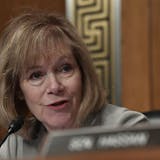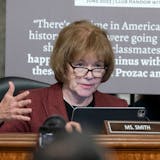Lt. Gov.-elect Peggy Flanagan's transition office on the third floor of the State Capitol is largely empty, save for a flip chart, some state government briefing booklets and a hefty binder titled "Governor's Office Transition Materials."
"There's not a lot in here on the role of the lieutenant governor," Flanagan said as she leaned on the massive binder. But she isn't disappointed by the lack of guidance. "It's exciting. And that provides an opportunity for us to continue to do what we do, which is reshaping this role and how it works."
Soon-to-be Gov. Tim Walz and his running mate Flanagan sold voters on a "One Minnesota" vision that included raising the minimum wage, universal pre-K and a MinnesotaCare buy-in. Now they must prioritize the long list of goals and work with a divided Legislature to make them a reality.
For Flanagan, that starts with the creation of the One Minnesota Transition Advisory Board. On Friday, she announced the members of the group who will help the administration get ready for Jan. 7, when Walz and Flanagan will be sworn in.
Labor leaders, members of the agriculture industry, corporate executives and higher education representatives are among the 30-person board that will work on ensuring that the governor's top staffers reflect the diversity of the state, as well as influencing the administration's policy agenda and the development of the next two-year budget.
Flanagan — who is leading the advisory board — said its creation is part of a commitment to bringing a range of voices into the governing process.
It also signals her continued prominence in the Walz administration.
With some exceptions, lieutenant governors in Minnesota have historically not played major roles in the policy work of the administration. Often, gubernatorial candidates pick someone to campaign with who will attract voters from a different geographic region. But a running mate's time in the public eye has often faded after Election Day.


